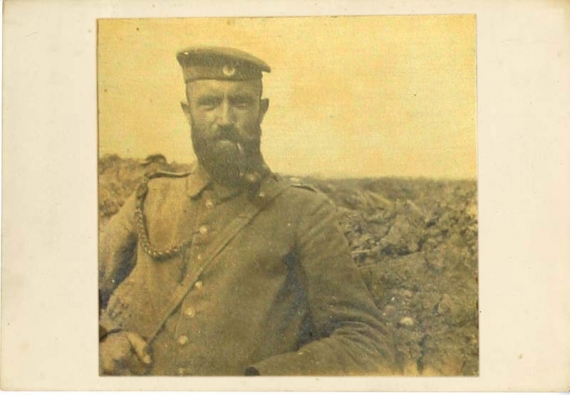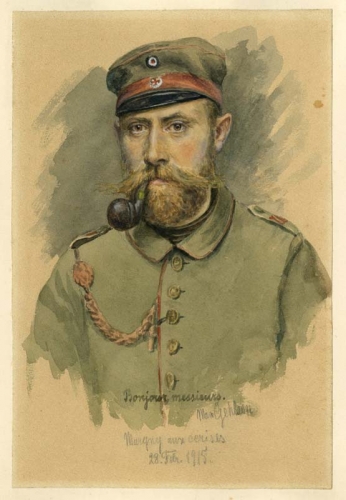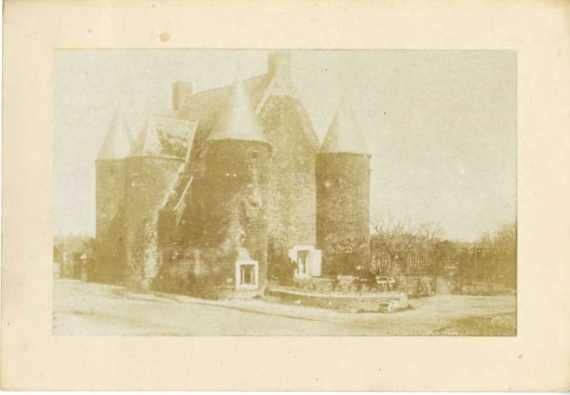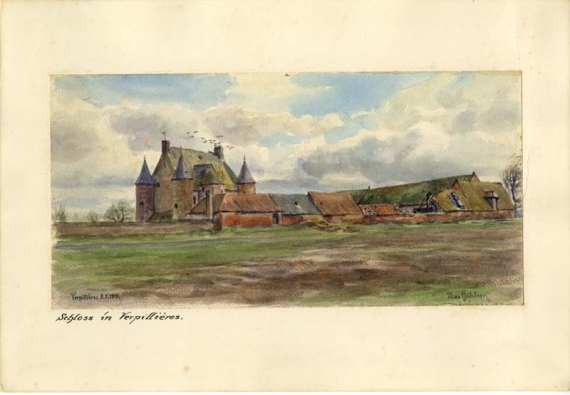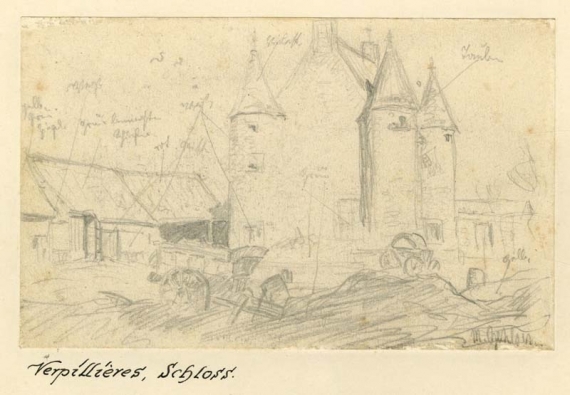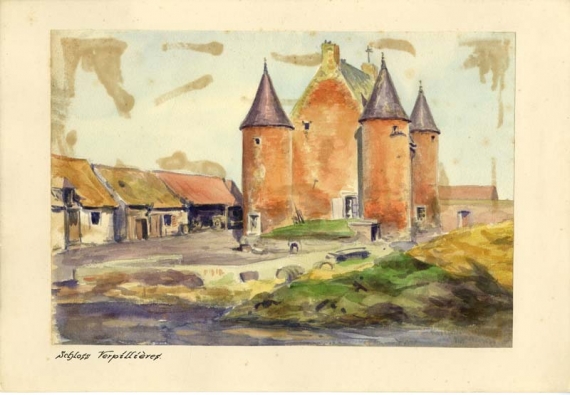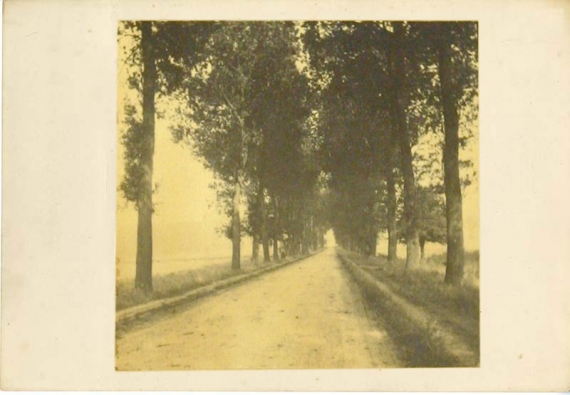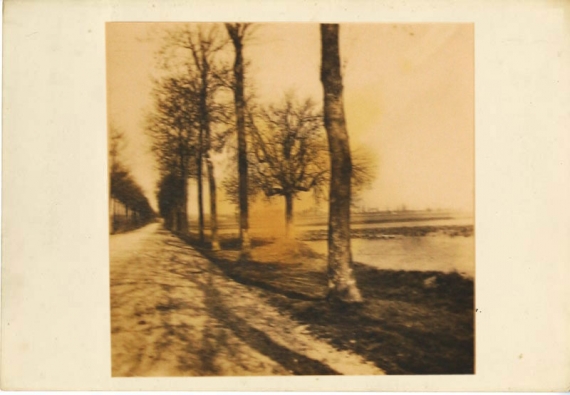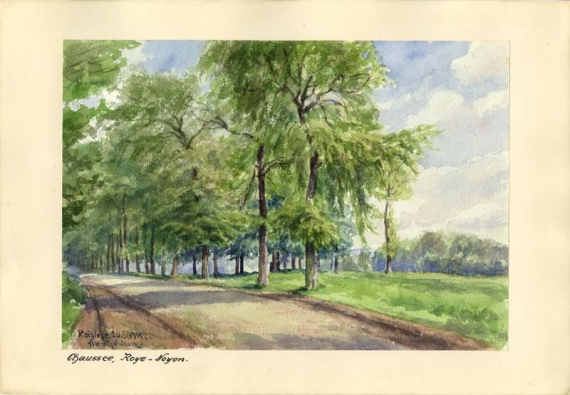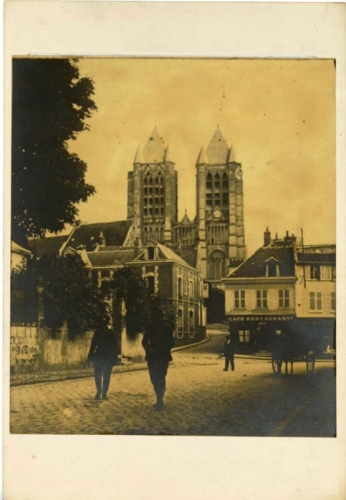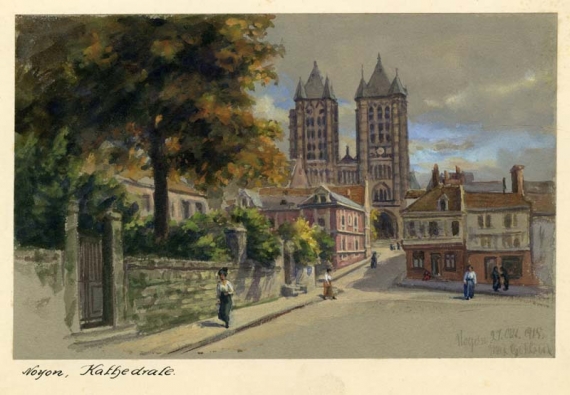Max GEHLSEN, Portrait de Max GEHLSEN, 1914-1915, tirage photographique monochrome noir et blanc, 5,5 x 5 cm
Représentant semble-t-il le peintre, cette photographie est l’un des documents personnels conservés dans les carnets écrits par Max GEHLSEN durant son séjour en France. Elle côtoie trois autres portraits de l’artiste pris à différentes périodes. La comparaison de ce cliché avec son autoportrait à l’aquarelle révèle l’importance de la photographie dans la genèse de son œuvre.
Archives départementales du Pas-de-Calais 47 FI 142_2
Max GEHLSEN, Bonjour messieurs, Margny-aux-cerises, 28 février 1915, aquarelle sur carton, 21 x 15 cm
Cette aquarelle est le seul autoportrait de l’artiste présent dans le fonds conservé par les archives départementales. Son autre particularité de cette aquarelle est l’inscription qui lui sert de titre, rédigée en français : « Bonjour messieurs ». Elle trouve peut-être son explication dans le fait que le modèle était vu dans ce costume par des Français, allusion humoristique à l'occupation. Max GEHLSEN s’est certainement inspiré de la photographie qui le représente dans une pose et un cadre similaire. L’uniforme est le même, mais quelques différences peuvent être remarquées : la forme de son couvre-chef, l’orientation de la pipe qu’il est en train de fumer, la pose de l’artiste et la lumière qui l’éclaire.
Archives départementales du Pas-de-Calais 47 FI 134_1
Max GEHLSEN, Verpillières, 1914-1915, tirage photographique monochrome noir et blanc, 9 x 5,5 cm
Archives départementales du Pas-de-Calais 47 FI 144_5
Max GEHLSEN, Château à Verpillières, 8 février 1915, aquarelle, gouache sur carton, 15 x 29,5 cm
La composition conçue par Max GEHLSEN place le château de Verpillères dans la partie gauche de l’œuvre, le corps de ferme occupant le reste de la largeur de la feuille. Cette disposition met en valeur le caractère imposant de l’ensemble.
Archives départementales du Pas-de-Calais 47 FI 83_1
Max GEHLSEN, Verpillières. Château, 1914-1915, crayon sur carton, 10,5 x 17 cm
Ce croquis est l’un des sept dessins préparatoires conservés dans le fonds Max GEHLSEN. Il est d'autant plus intéressant qu'il peut être comparé à la photographie initiale et à l’aquarelle peinte à partir de cette esquisse. il permet ainsi d’observer une autre étape du travail de création. Le point de vue retenu est très proche de celui de la photographie et illustre l'importance de cette dernière dans le processus d'élaboration. Des annotations complémentaires indiquent les couleurs qui seront utilisés pour rendre les éléments du paysage.
Archives départementales du Pas-de-Calais 47 FI 139_2
Max GEHLSEN, Verpillières. Château, 1915, aquarelle sur carton, 20 x 29 cm
Archives départementales du Pas-de-Calais 47 FI 136_1
Max GEHLSEN, Chaussée Noyon-Roye, 1914-1915, tirage photographique monochrome noir et blanc, 5,5 x 5,5 cm
Des arbres forment une haie régulière de part et d’autre de la chaussée qui relie Noyon à Roye, dans le département de l’Oise. La photographie est prise dans l’axe de la route. L’appareil est placé presque au centre de celle-ci, donnant une perspective très profonde à l’image. Ce cliché, l'un des souvenirs personnels de l’artiste, lors de son passage sur le front Ouest durant la Grande Guerre, l'a peut-être aidé à peindre une autre de ses aquarelles qui représente également cette route de Noyon à Roye.
Archives départementales du Pas-de-Calais 47 FI 142_10
Max GEHLSEN, Roye-Noyon, 1914-1915, tirage photographique monochrome noir et blanc, 5,5 x 5,5 cm
Cette photographie de la route reliant Roye à Noyon, bordée d’arbres sans feuilles, sans traces visibles de combat, a sans doute été prise en hiver. Le cliché, un peu flou et marqué d’une tache jaune, rappelle l’aquarelle qui traite le même sujet à partir d’un angle de vue similaire. Il est fort possible qu'il ait inspiré la perspective très abrupte adoptée dans l'œuvre achevée.
Archives départementales du Pas-de-Calais 47 FI 144_9
Max GEHLSEN, Roye-Noyon. Chaussée, 20 mai 1915, aquarelle, gouache sur carton, 28 x 19,5 cm
Cette aquarelle représente une portion de la route qui relie Roye à Noyon. La chaussée est bordée par deux sentiers, le long desquels se déploient des arbres plantés à intervalles réguliers. La composition de l’œuvre met ceux-ci en avant: leurs silhouettes et leur alignement occupent les deux tiers supérieurs de la feuille. La route, rendue selon une perspective oblique, n’est ainsi qu’un prétexte pour peindre la verdure qui la longe. Max GEHLSEN s'est probablement appuyé sur deux photographies qui représentent le même sujet, mais prises sous des angles de vue légèrement différents.
Archives départementales du Pas-de-Calais 47 FI 92_1
Max GEHLSEN, Noyon, 1914-1915, tirage photographique monochrome noir et blanc, 8 x 9 cm
Les deux tours de la façade occidentale de la cathédrale de Noyon émergent derrière les maisons environnantes. L’angle de vue, retenu par GEHLSEN, présente un premier plan dégagé, animé par quelques promeneurs à cheval. Le regard est conduit jusqu’aux tours de la cathédrale qui ferment la perspective. Ce cadrage, fréquent chez GEHLSEN, renforce la majesté de l’édifice religieux, qui semble dominer la vie de la cité. Ici encore le support photographique vient compléter et aider à la réalisation de l’aquarelle.
Archives départementales du Pas-de-Calais 47 FI 142_12
Max GEHLSEN, Noyon. Cathédrale, 27 mai 1915, aquarelle, gouache sur carton, 14 x 21 cm
Rien ou presque ne permettrait de rappeler l'occupation et la guerre, dans cette aquarelle représentant Noyon, pourtant dernière plaque tournante des troupes allemandes sur la route de Paris: seuls quelques civils traversent les rues, des femmes principalement. Au fond, se détache la silhouette imposante de la cathédrale. Au moyen de puissantes lignes de fuite (celle du trottoir de gauche notamment), l'artiste guide le regard vers le portail droit de la façade principale de l'édifice.
Archives départementales du Pas-de-Calais 47 FI 39_2


















